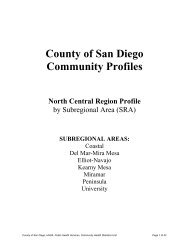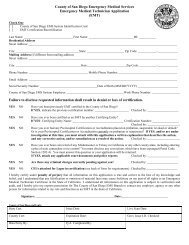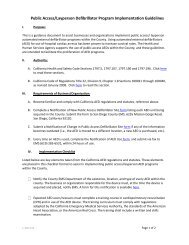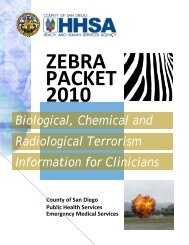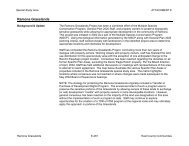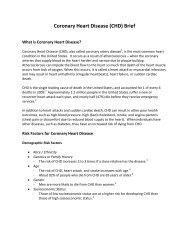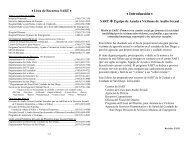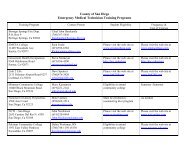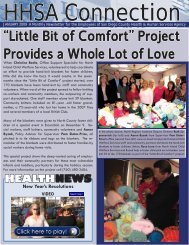CALIFORNIA CODE OF REGULATIONS - State of California
CALIFORNIA CODE OF REGULATIONS - State of California
CALIFORNIA CODE OF REGULATIONS - State of California
Create successful ePaper yourself
Turn your PDF publications into a flip-book with our unique Google optimized e-Paper software.
§ 1929 <strong>CALIFORNIA</strong> <strong>CODE</strong> <strong>OF</strong> <strong>REGULATIONS</strong><br />
Page 554<br />
be prescribed for, administered to, or passed to a child.<br />
(4) Procedures for monitoring psychotropic medications by a<br />
person licensed to prescribe or dispense prescription drugs, with the<br />
current name and qualifications <strong>of</strong> the person who shall conduct the<br />
monitoring.<br />
(b) Any psychotropic medication control and/or monitoring<br />
practices employed by a designated CTF licensed mental health<br />
pr<strong>of</strong>essional shall ensure that any use <strong>of</strong> prescribed psychotropic<br />
medications are consistent with the goals and objectives <strong>of</strong> a child’s<br />
NSP.<br />
NOTE: Authority cited: Section 4094, Welfare and Institutions Code.<br />
Reference: Sections 4094 et seq., Welfare and Institutions Code; and<br />
Section 1502, Health and Safety Code.<br />
§ 1929. Restraint and Seclusion.<br />
(a) Physical restraint and seclusion shall be used only when<br />
alternative methods are not sufficient to protect the child or others<br />
from immediate injury.<br />
(b) Physical restraint and seclusion shall not be used as aversive<br />
treatment, punishment, as a substitute for more effective<br />
programming, or for the convenience <strong>of</strong> the staff.<br />
(c) Physical restraint and seclusion shall only be used with a written<br />
order designed to lead to a less restrictive way <strong>of</strong> managing, and<br />
ultimately eliminating, the behavior for which the physical restraint<br />
or seclusion is applied.<br />
(d) A CTF shall adhere to written policies and procedures<br />
concerning the use <strong>of</strong> physical restraints and seclusion that include:<br />
(1) A medical evaluation <strong>of</strong> each child upon admission to the<br />
facility to determine the existence <strong>of</strong> any condition that would<br />
contraindicate the use <strong>of</strong> physical restraint or seclusion;<br />
(2) A requirement that they be used only with a signed order <strong>of</strong> a<br />
physician or licensed psychologist, except in an emergency as defined<br />
in Section 1901(K). In such an emergency a child may be placed in<br />
physical restraint at the discretion <strong>of</strong> a registered nurse. An order shall<br />
be received by telephone within sixty (60) minutes <strong>of</strong> the application<br />
<strong>of</strong> physical restraint, and shall be signed by the prescriber within<br />
twenty–four (24) hours. Telephone orders shall be received only by<br />
authorized mental health pr<strong>of</strong>essional staff, and shall be recorded<br />
immediately in the child’s facility record;<br />
(A) The order shall include reasons for the physical restraint or<br />
seclusion in specific behavioral terms, type and number <strong>of</strong> points, if<br />
applicable, conditions for release or termination <strong>of</strong> physical restraint,<br />
with specific directions for discussing with the child the conditions<br />
that required the application <strong>of</strong> the physical restraint, the level <strong>of</strong><br />
nursing care the child is entitled to while in physical restraint and the<br />
types <strong>of</strong> behaviors that will meet the criteria for terminating the order<br />
for physical restraint.<br />
(B) Full documentation <strong>of</strong> the episode leading to the use <strong>of</strong> physical<br />
restraint, including the antecedent behaviors, and less restrictive<br />
means attempted by staff prior to the use <strong>of</strong> physical restraint, the type<br />
<strong>of</strong> physical restraint used, the length <strong>of</strong> effectiveness <strong>of</strong> the physical<br />
restraint time and the name <strong>of</strong> the individual applying such measures<br />
shall be entered in the child’s facility record.<br />
(C) At the time physical restraint or seclusion is initiated, or as soon<br />
as practical, but in every case within one (1) hour, information<br />
regarding the child’s medical condition including vital signs,<br />
medications, current medical treatments and any relevant medical<br />
circumstances specific to the child shall be reviewed by the facility’s<br />
on duty licensed nursing staff and noted in the child’s facility record.<br />
(D) All orders for physical restraint shall become invalid two (2)<br />
hours after the restraint or seclusion is initiated for children ages 9 to<br />
17, one (1) hour for children under age 9, and four (4) hours for any<br />
special education pupils ages 18 through 21 remaining in the facility<br />
under continuing stay provisions. If continued physical restraint or<br />
seclusion is needed a new order shall be required.<br />
(3) A prohibition that physical restraint shall not be allowed for<br />
longer than twenty–four (24) hours;<br />
(4) A prohibition against as–needed, also known as “PRN” orders<br />
for physical restraint or seclusion.<br />
(5) A description <strong>of</strong> acceptable forms <strong>of</strong> physical restraint or<br />
seclusion which shall be:<br />
(A) Seclusion in either a designated seclusion room with a door<br />
which may be held shut to prevent a child’s egress by a staff member<br />
or by a mechanism which releases upon removal <strong>of</strong> a staff person’s<br />
foot and/or hand or in any other room or part <strong>of</strong> the facility where the<br />
child is prevented from physically leaving for any period <strong>of</strong> time, thus<br />
limiting their movement, activities and contact with the other<br />
children;<br />
(B) Physical containment <strong>of</strong> a child by two or more trained staff<br />
persons utilizing methods approved by the Department;<br />
(C) The application <strong>of</strong> mechanical devices such as well padded<br />
belts and cuffs, mittens without thumbs which are securely fastened<br />
about the wrist with a small tie and vests consisting <strong>of</strong> sleeveless cloth<br />
webbing;<br />
(6) A requirement that restraint shall be applied in such a way as<br />
not to cause physical injury and to insure the least possible discomfort<br />
to the child;<br />
(7) A requirement that restraints using mechanical devices shall be<br />
applied in such a manner that the device can be speedily removed in<br />
case <strong>of</strong> fire or other emergencies;<br />
(8) A requirement that staff shall make provisions for regularly<br />
scheduled periods, at intervals not to exceed two (2) hours, for range<br />
<strong>of</strong> motion exercises, toileting and access to liquids and meals;<br />
(9) A requirement that staff shall make provisions for responding<br />
promptly and appropriately to a child’s request for services and<br />
assistance, and for repositioning the child when appropriate;<br />
(10) A requirement for staff to take all precautions to insure the<br />
safety <strong>of</strong> children in restraints by insuring that they remain in staffs’<br />
line <strong>of</strong> vision, by isolating them from other children and by insuring<br />
that the restraints can be easily removed in case <strong>of</strong> fire or emergency;<br />
(11) A requirement that staff shall make provisions to insure that<br />
a child placed in physical restraint shall be checked at a minimum <strong>of</strong><br />
every fifteen (15) minutes by the licensed nursing staff to insure that<br />
the restraint remains properly applied and that the child has not<br />
harmed himself. A written record <strong>of</strong> each check shall be placed in the<br />
child’s record and shall include:<br />
(A) Vital signs which shall be measured at least every half hour,<br />
unless otherwise indicated by the prescribing pr<strong>of</strong>essional;<br />
(B) Justification for continued physical restraint;<br />
(C) The child’s responses to information regarding his behavioral<br />
criteria for termination <strong>of</strong> the physical restraint.<br />
(e) A child’s parent, conservator or the person identified by the<br />
court to manage the placement shall be informed <strong>of</strong> a restraint or<br />
seclusion within twenty four (24) hours, excepting weekends.<br />
(f) Under no circumstances shall physical restraint be used as a<br />
disciplinary action.<br />
NOTE: Authority cited: Section 4094, Welfare and Institutions Code.<br />
Reference: Sections 4094 et seq., Welfare and Institutions Code; and<br />
Section 1502, Health and Safety Code.<br />
§ 1930. Discipline Practices.<br />
(a) The applicant or certificate holder shall develop, maintain and<br />
implement written discipline practice policies that are consistent with<br />
the NSP <strong>of</strong> the child and ensure that all staff follow these procedures<br />
when disciplining a child including the following:<br />
(1) A directive that under no circumstance shall physical restraint<br />
be used as a disciplinary action;<br />
(2) Reviews, to include a licensed mental health pr<strong>of</strong>essional, <strong>of</strong><br />
each disciplinary action initiated by staff;<br />
(3) Joint reviews by the program director, licensed mental health<br />
pr<strong>of</strong>essionals, and the facility staff <strong>of</strong> discipline practices approved<br />
for use within the facility.<br />
(b) A CTF shall provide placing agencies, children placed in a CTF,<br />
parents, conservators, or the person identified by the court to manage



